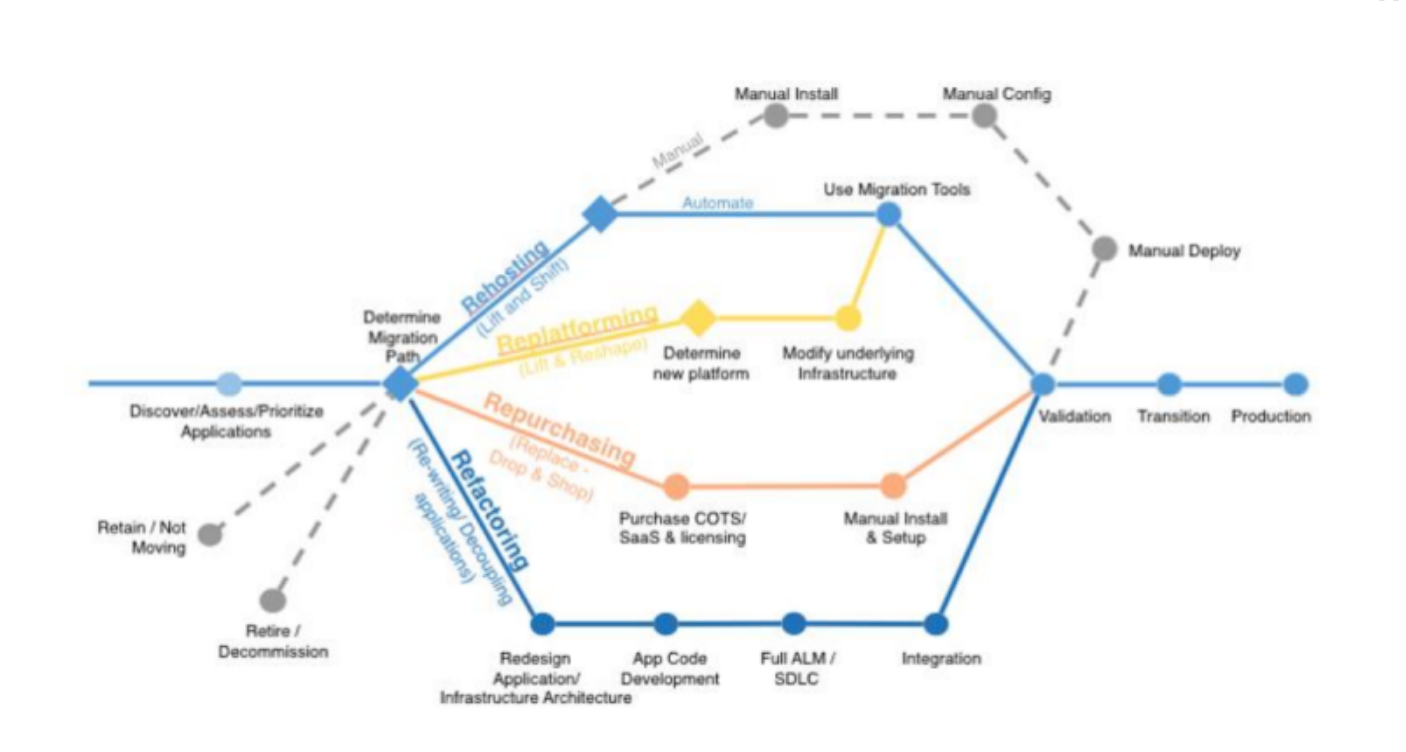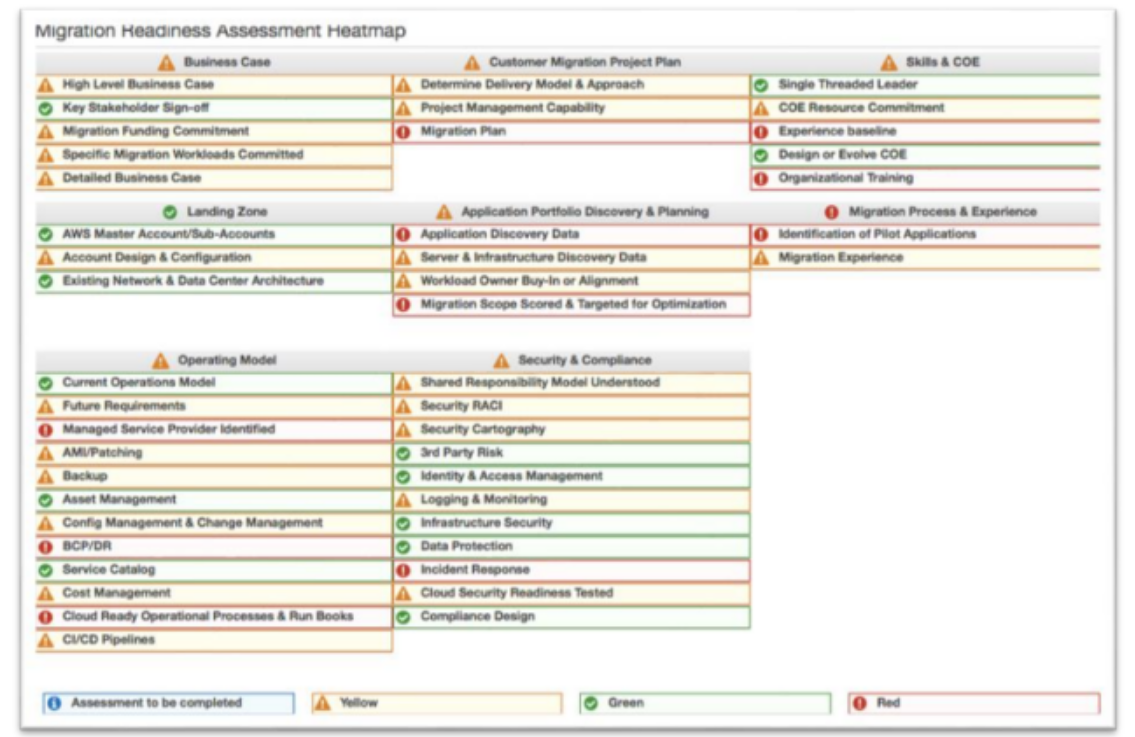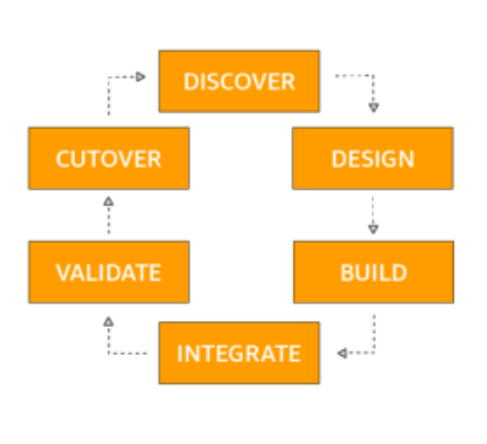AWS Migration Whitepaper (2018)
- The Cloud Adoption Framework (AWS CAF)
- Organization Change Management
- Business Drivers
- Migration Strategies
- Building a Business case for Migration
- People and Organization
- Migration Readiness and Planning (MRP)
- Migrating
The Cloud Adoption Framework (AWS CAF)
The business plan should consider and incorporate the following areas:
- business
- people
- governance
- platform
- security
- operations
Organization Change Management
- Organization change management framework helps drive the desired changes throughout your organization
- Accelerates cloud transformation
- Mobilize Team
- Align Leaders
- Envision the Future
- Engage the Organization
- Enable Capacity
- Make it Stick
Mobilize Team, Align Leaders Objectives:
- Confirm sponsorship
- SEcure resource, expertise
- Form strong coalition of leaders
- Build momentum Key Actions:
- Form team to lead change - executive sponsors, stakeholders, line leaders, PMO, change management communication, training, etc.
- Establish program charter, roles, milestones
- Build guiding coalition, mobilize leadership
- Shape program governance structure
- Access and align change leadership roles
Envision the Future, Engage the Organization Objectives:
- Articulate vision and roadmap for transition to Cloud
- Mobilize organizations, build commitment, create change urgency
- Establish communication channels to gain and maintain buy-in, support and participation throughout entire transition Key Actions:
- Leaders communicate future Cloud vision (via comprehensive messaging plan)
- Impacted business leaders reinforce new op model (process/tech/org)
- Identify/assess impacted stakeholders
- Enlist and mobilize Change Champion Network
- Drive ongoing communication, feedback - two-way conversations
- Address “How does this impact me?”
- Celebrate progress and control issues
Enable Capacity, Make it Stick Objectives:
- Ensure successful transition to Cloud
- Align IT org structure, roles, processes with AWS Cloud Platform
- Ensure all IT staff/key stakeholders can operate in new environment
- Ensure Cloud benefits and objectives are achieved Key Actions:
- Identify change impacts to IT roles, policy, org structure, process, etc
- Modify IT roles, org structure, job descriptions and processes (if needed) to support AWS Cloud
- Align IT staff to new operating model
- Develop and implement targeted training
- Setup measurement structures
- Measure and evaluate outcomes
- Course correct where needed
Business Drivers
- Operational Costs
- Costs of running your infrastructure
- Matching supply and demand
- Investment risk for new applications
- IT operating model
- Workforce Productivity
- How efficiently you are able to get your services to market
- Workforce productivity improvements of 30%-50% following a large migration
- Cost Avoidance
- Setting up environment that does not create unnecessary costs
- Hardware refresh cost
- Operational Resilience
- Reducing organization’s risk profile and the cost of risk mitigation
- Improved performance
- Improved uptime and risk-related costs
- Business Agility
- Ability to react quickly to changing market conditions
- Speed, standardization, and flexibility develop when you use DevOps models, automation, monitoring, and auto-recovery or high-availability capabilities
Migration Strategies
“6 R” Framework:
- Re-host
- Re-factor / Re-architect
- Re-purchase
- Retire
- Retain

Choosing the Right Migration Strategy
Factors:
- Business drivers for cloud adoption
- Time considerations
- Business and financial constraints
- Resource requirements
Building a Business case for Migration
Questions:
- What is the future expected IT cost on AWS versus existing (base) cost?
- What are the estimated migration investment costs?
- What is the expected ROI, and when will hte project be cash flow positive?
- What are the business benefits beyond cost savings?
- How will using AWS improve our ability to respond to business changes?
Categories:
- Run cost analysis
- TCO comparison of run costs on AWS post-migration vs. current operating model
- Impact of AWS purchasing/pricing options (RI, Volume discounts)
- Impacts of AWS discounts (Enterprise Discount Program, service credits, etc..)
- Cost of change
- Migration planning/consulting costs
- Compelling events (planned refresh, data center lease renewal, divestiture)
- Change management (training establishment of a Cloud Center of Excellence, governance, and operations model)
- Labor productivity
- Estimate of reduction in number of hours spent conducting legacy operational activities (requisitioning, racking, patching)
- Productivity gains from automation
- Developer productivity
- Business value
- Agility
- Cost avoidance
- Risk mitigation
People and Organization
Establish operational processes and form a Cloud Center of Excellence (CCoE). CCoE is dedicated to mobilizing the appropriate resources and will lead your company through organizational and business transformations over the course of the migration effort.
Creating a Cloud Center of Excellence (CCoE)
- The CCoE structure will evolve and change as your organization transforms. Diverse, cross-functional representation is key.
- Treat the cloud as your product and the application team leaders as your customers. Drive enablement, not command and control.
- Build company culture into everything you do.
- Organizational change management is central to business transformation. Use intentional and targeted organizational change management to change company culture and norms.
- Embrace a change-as-normal mindset. Change of applications, IT systems, and business direct is expected.
- Operating model decisions will determine how people fill roles that achieve business outcomes.
Structure of CCoE
- CCoE is comprised of two functional groups:
- Cloud Business Office (CBO)
- Making sure that the cloud services meet hte needs of your internal customer
- IT should adopt a customer-centric model toward business application owners
- Organizational change management
- Stakeholder requirements
- Governance
- Cost Optimization
- Vendor management, internal marketing, communications and status updates to users
- Cloud Engineering
- Infrastructure automation
- Operational tools and processes
- Security tooling and controls
- Migration landing zones
- Performance, availability, security
- Cloud Business Office (CBO)
Migration Readiness and Planning (MRP)
- Set of tools, processes and best practices to prepare an enterprise for cloud migration
- Aligns to AWS Cloud Adoption Framework and is execution driven
Assessing Migration Readiness
- Have you clearly defined the scope and the business case for the migration?
- Have you evaluated the environment and applications in scope through the lenses of AWS CAF?
- Is your VPC secure, can it act as a landing zone for all applications in scope?
- Have your operations and employee skills been reviewed and updated to accommodate the change?
- Do you have the experience necessary to move the tech-stacks that are in scope?
Migration Readiness Assessment (MRA):
- Identifies readiness gaps
- Makes recommendations to fill those gaps in preparation for a large migration effort
- To be completed interactively involving key stakeholders

Application Discovery
- Understanding on-premises environment
- Determine what servers / devices exist
- Determine applications running on the devices
- Configuration Management Database (CMDB) helps with high-level analysis
- Recommend using automated discovery tool
- Environment may change over time
- Plan how to keep your data current by continuously running automated discovery tool
Discovery Tools
- AWS Marketplace, Migration category
- AWS ADS - Application Discovery Service
- Discovery server inventories and performance characteristics
- Uses an appliance connect for virtual servers
- Uses agents installed on physical or virtual hosts
Features of application discovery tool:
- Automatically discover infra and application running in your data center
- Maintain the inventory
- Reveal application / infrastructure dependencies
- Inventory versions of operating systems
- Determine performance baselines and optimization opportunities
- Provide means to categorize applications and servers
Application Portfolio Analysis
- Broad categorization of resources aligned by common traits
- Identify special cases that need special handling
- Identify the order of migration and the migration strategy (based on 6 R’s)
Migration Planning
- Review of project management methods, tools, and capabilities to assess any gaps
- Define project management methods and tools to be used during the migration
- Define and create the Migration Project Charter/Communication Plan including reports and escalation procedures
- Develop a project plan, risk/mitigation log, and roles and responsibilities matrix (e.g. RACI) to manage the risks that occur during the project and identify ownership for each resource involved
- Procure and deploy project management tools to support the delivery of the project
- Identify key resources and leads for each of the migration work streams
- Facilitate the coordination and activities outlined in the plan
- Outline resources, timelines, and cost to migrate the target environment to AWS
Technical Planning
- Gather information about architecture of each application
- Get through each application before beginning execution of the plan
- Be agile: do a deep analysis of the first two to three prioritize apps, begin the migration
- Continue deeper analysis of the next applications in parallel
- Iterative process, with backlog of applications for each migration team
The Virtual Private Cloud Environment
Security AWS CAF Security Perspective - structured approach to help build a foundation of security, risk, and compliance capabilities that will accelerate your readiness and planning for a migration project.
AWS CAF 10 themes:
- Five core security themes
- Identity and Access Management
- Detective Control
- Infrastructure Security
- Data Protection
- Incident Response
- Five augmenting security themes (operational excellence through availability, automation and audit)
- Resilience
- Compliance validation
- Secure continuous integration/continuous deployment (CI/CD)
- Configuration vulnerability analysis
- Security big data analytics
Operations
Defines current operating procedures and identifies the process changes and training that is needed for successful cloud adoption. Determine Cloud Operation Model (COM) for a particular application or set of application when envisioning the future state.
- Service Monitoring
- Application Performance Monitoring
- Resource Inventory Management
- Release Management / Change Management
- Reporting and Analytics
- Business Continuity / Disaster Recovery
- IT Service Catalog
Create Cloud Services Organizations - to build an organization that is capable of delivering and consuming cloud services, which consists of:
- CCoE - Cloud Center of Excellence
- CBO - Cloud Business Office
- Cloud Shared Services teams
- COM - Cloud Operations Model
Platform
- Compute Provisioning
- Network Provisioning
- Storage Provisioning
- Database Provisioning
- Systems and Solution Architecture
- Application Development
Key elements of the platform work stream:
- AWS landing zone
- Initial structure and pre-defined configurations for AWS accounts, networks, identity and billing frameworks and customer-selectable optional packages
- Account structure
- Network structure
- Pre-defined identity and billing frameworks
- Pre-defined user-selectable packages
Migrating
First Migrations - Build Experience
- First migrated applications build confidence and experience
- Informs the migration plan (MRP) with the patterns and tool choices that fit your organization’s needs
- Provides validation and testing of the operational and security processes
Considerations:
- Identify patterns (architectures, tech stacks, etc..) in the portfolio to create a list of application groupings based on common patterns. This creates a common process for group migrations.
- First three to five applications should be representative of common patterns in your portfolio.
Application Migration Process
- Discover
- Discovering information about application
- Discovery Business Information (DBI)
- Discovery Technical Information (DTI)
- Discovering information about application
- Design
- Developing and documenting target state
- AWS architecture
- Application Architecture
- Supporting operational components and processes
- Includes information about data flow, foundational elements, monitoring design, and how the application will consume external resources
- Developing and documenting target state
- Build
- Migration team is selected based on the migration strategy chosen for the application
- Using pre-defined methods and tools to migrate to AWS
- Integrate
- Migration team makes external connections for the application
- Validate
- Series of specific tests before cutover stage
- Verification, functional, performance, disaster recovery, and business continuity tests
- Cutover
- User acceptance test
- Use outlined rollback procedure in the cutover plan if the migration is not successful

Team Models
- Cloud Business Office (Program Control)
- Manages resources and budgets
- Manages and reports risk
- Drives communication and change management
- Cloud Engineering & Operations
- Builds and validates fundamental components
- Ensure development, test and prod env are scalable, automated, maintain and monitored
- Prepares landing zones as needed for migrations
- Innovation
- Repeatable solutions that will expedite migrations
- Larger and more complex technical issues for the migration teams
- Portfolio Discovery & Planning
- Accelerate downstream activities
- Executes application discovery and optimizing application backlogs
- Eliminate objections and minimize wasted effort
Migration Factory Teams
- Multiple teams operating concurrently on migration project
- Factory teams are self-sufficient and include five to six cross-functional roles
- business analysts and owners, DevOps professionals, migration engineers, and developers
- Migration team patterns:
- Re-host migration team
- High-volume, low-complexity applications that don’t require material change
- Leverages migration automation tools
- Patch and release management process
- Re-platform migration team
- Re-factor/re-architect migration team
- Re-host migration team